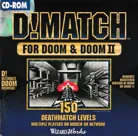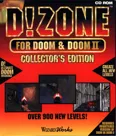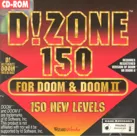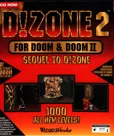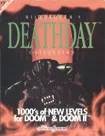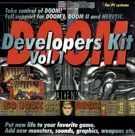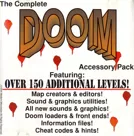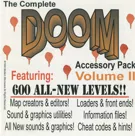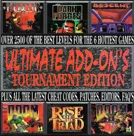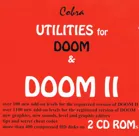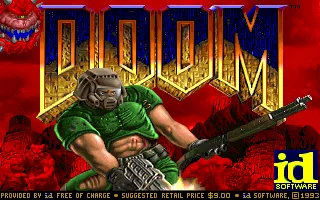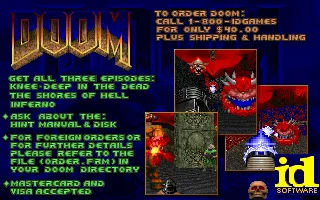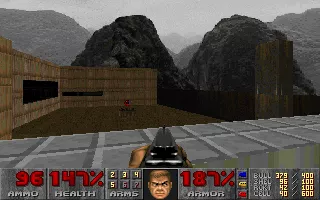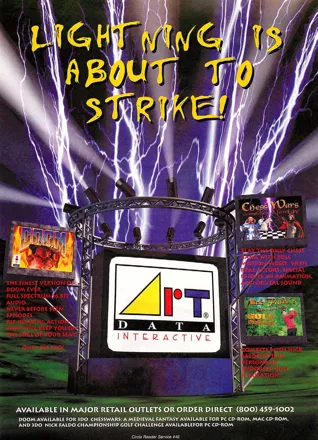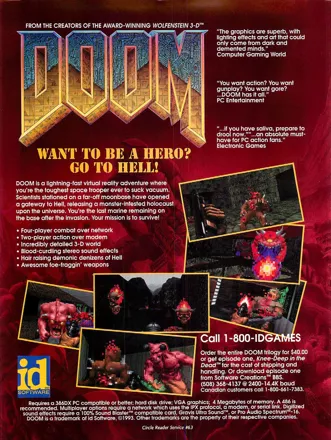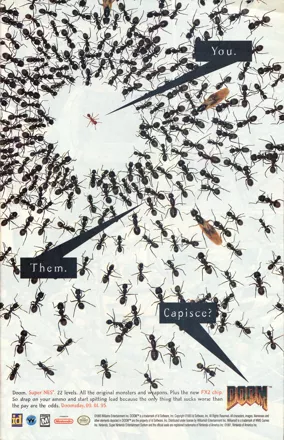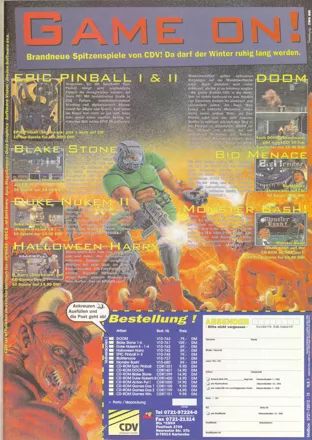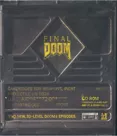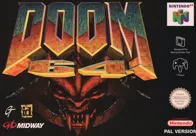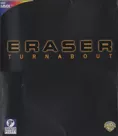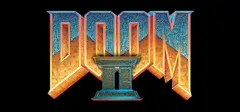Doom
-
 Doom
(1995 on
PlayStation, 1997 on
SEGA Saturn)
Doom
(1995 on
PlayStation, 1997 on
SEGA Saturn)
-
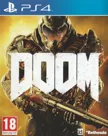 Doom
(2016 on
Windows,
PlayStation 4,
Xbox One...)
Doom
(2016 on
Windows,
PlayStation 4,
Xbox One...)
-
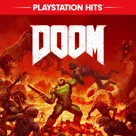 Doom
(2017 on
PlayStation 4)
Doom
(2017 on
PlayStation 4)
Description official descriptions
The Union Aerospace Corporation has been experimenting with teleportation technology on Mars' moons Phobos and Deimos. After early successes, something goes wrong. It seems the scientists have opened a gateway straight to Hell. Phobos base is overrun with demonic creatures, and the whole of Deimos simply vanishes. A squad of marines is sent to Phobos, but all except one are quickly slaughtered. It falls to the surviving marine to grab some guns and strike back at the demons.
id Software's follow-up to their genre-defining Wolfenstein 3D, Doom is another first-person 3D shooter: full-on action as seen from the space marine's perspective. Like Wolfenstein, the game consists of distinct episodes, playable in any order. The first episode, Knee-Deep in the Dead, takes place in the Phobos base and is freely available as shareware. The full game continues on Deimos in The Shores of Hell and culminates in Inferno, the final episode which takes place in Hell itself (the Sega 32x version lacks this episode).
The basic objective in each level is simply to reach the exit. Since dozens of enemies stand in the way, the only way to get there is by killing them. Switches and buttons must be pressed to advance at certain points and often color-coded locked doors will block the way - matching keycards or skull keys must be found to pass.
The game's engine technology is more advanced than Wolfenstein's, and thus the levels are more varied and complex. The engine simulates different heights (stairs and lifts appear frequently) and different lighting conditions (some rooms are pitch black, others only barely illuminated). There are outdoor areas, pools of radioactive waste that hurt the player, ceilings that come down and crush him, and unlike Wolfenstein's orthogonally aligned corridors, the walls in Doom can be in any angle to each other. An automap helps in navigating the levels.
Stylistically, the levels begin with a futuristic theme in the military base on Phobos and gradually change to a hellish environment, complete with satanic symbols (pentagrams, upside-down-crosses, and portraits of horned demons), hung-up mutilated corpses, and the distorted faces of the damned.
Doom features a large weapon arsenal, with most weapons having both advantages and drawbacks. The starting weapons are the fists and a simple pistol. Also available are a shotgun (high damage, slow reload, not good at distances), a chaingun (high firing rate, but slightly inaccurate in longer bursts), and a plasma rifle (combining a high firing rate and large damage). The rocket launcher also deals out lots of damage, but the explosion causes blast damage and must be used with care in confined areas or it might prove deadly to the player as well as the enemies. Two further weapons in the game are the chainsaw for close-quarter carnage, and the BFG9000 energy gun, which while taking some practice to fire correctly, can destroy most enemies in a single burst. The different weapons use four different ammunition types (bullets, shells, rockets, and energy cells), so collecting the right type for a certain gun is important.
The game drops some of Wolfenstein's arcade-inspired aspects, so there are no extra lives or treasures to be collected for points, but many other power-ups are still available. Medpacks heal damage while armor protects from receiving it in the first place. Backpacks allow more ammunition to be carried, a computer map reveals the whole layout of the level on the automap (including any secret areas), light amplification visors illuminate dark areas and radiation suits allow travel over waste without taking damage. Also available are berserk packs (which radically increase the damage inflicted by the fists) as well as short-time invisibility and invulnerability power-ups.
The enemies to be destroyed include former humans corrupted during the invasion, plus demons in all shapes and sizes: fireball-throwing imps, floating skulls, pink-skinned demons with powerful bite attacks, and large one-eyed flying monstrosities called Cacodemons. Each episode ends with a boss battle against one or two, particularly powerful creatures.
Doom popularized multiplayer in the genre with two different modes: Cooperative allows players to move through the single-player game together, while Deathmatch is a competitive game type where players blast at each other to collect 'frag' points for a kill and re-spawn in a random location after being killed.
The 3DO and Sega32x ports lack any multiplayer modes, though the other ports retain the DOS versions multiplayer to varying degrees. The various console ports all feature simplified levels and omit some levels, enemies, and features from the original DOS release. The SNES and Gameboy Advance versions of the game actually use different engines and hence feature numerous small gameplay differences.
Spellings
- ドゥーム - Japanese spelling
- 毁灭战士 - Simplified Chinese spelling
Groups +
- 3D Engine: id Tech 1
- BPjS / BPjM indexed games
- Doom series
- Gameplay feature: Auto-mapping
- Gameplay feature: Recordable replays
- Games made into books
- Games made into comics
- Games referenced in movies
- Games with officially released source code
- Setting: Hell
- Setting: Mars
- Visual technique / style: Digitized sprites
- Weapon: Chainsaw
Screenshots
Promos
Credits (DOS version)
15 People
| Design | |
| Programming / Software Engineers | |
| Graphics / Artwork | |
| Tech Support | |
| Level Design | |
| Music | |
| Sound Effects | |
| Sound | |
| Tools Programming | |
| Audio Drivers | |
| Model Development | |
| Cover Illustration | |
| Creative Director | |
| Biz / Chief Executive Officer |
Reviews
Critics
Average score: 84% (based on 77 ratings)
Players
Average score: 3.7 out of 5 (based on 743 ratings with 39 reviews)
The Good
It was fun when I first played it. The graphics were amazing, as was the sound. It was great, mindless fun. I loved it. Then....then I played System Shock, a game that surpasses Doom in every way imaginable. Well, except the mindless fun part.
The Bad
Repetitive, boring gameplay. Fun at first, but you do the same thing in every level, which all look the same. There is no plot. Well, there's something about gates to hell and such, but I don't consider a blurb in the readme to be a plot, per se. It's just....boring. Nothing of interest, really.
The Bottom Line
A decent, albeit brainless game. Provides some fun for a while, but around the fourth or fifth level, I realized that I was doing the same thing: Shooting monsters, looking for the exit sign. I'd much rather face a crazed, power-mad sentient computer that takes a perverse pleasure in tormenting the player, a la SHODAN in System Shock. But hey, who wants a challenging game when you can click the "fire" button three thousand times a minute?
DOS · by Doug Peterson (5) · 2002
Simply put, one of the most important FPS games of all time.
The Good
I will say right of the bat that this game, along with Super Mario All Stars on the SNES, made me become a gamer. I have been playing this game since I was five or something and even to this day I still play it regularly.
Obviously, the first thing that made DOOM such a great game for me, is its gameplay. Of course, on paper it does not say much. You go from point A to point B, killing everything in sight and collecting keys. Rinse and repeat for as long as the game goes. But it is that particular simplicity that contributes to its great gameplay. It is pure, non-nonsense, high octane action all way through. A variety of weapons, enemies and levels will keep you entertained till the very end.
With pistols, shotguns, rocket launchers, chainsaws and more you have more than enough to use against the numerous zombies, imps, gorilla-like demons, flaming skulls and of course the famous Bruiser brothers. Every monster has its own strengths and weaknesses and you really need to adjust your strategy depending what weapons you have at your disposal and what monsters you are facing. Do not start using a pistol against something like a Baron of Hell or a rocket launcher against a swarm of charging Lost Souls.
But DOOM's gameplay is not its only asset. Its graphics and presentation as a whole definitely deserve as much praise. Yes, compared to today everything in the game looks like a hellish, ultra-violent version of a Looney Tunes cartoon, but for 1993, DOOM's graphics were nothing short of a revolution. DOOM was the first game that really created a realistic looking environment. Using differing lighting effects, varying heights and fully textured levels it was finally possible to walk through caves that looked like caves and buildings that looked like buildings.
And then there is the atmosphere, which was far ahead of its time as well and still remains compelling even to this day. Both the tech and hell levels manage to look believable. Tech levels have terminals showing useless info, cargo boxes and huge, important looking doors. Hell levels have rivers of blood and lava, dark caves and caverns with rock or flesh walls and hanging, mutilated bodies everywhere.
Finally, there is the music and sound effects. For music, DOOM uses heavy metal music based on songs by Pantera, Slayer and Metallica for many levels while others have dark and atmospheric music made by Bobby Prince. Even people who do not like metal music or dark ambient music will certainly like DOOM's soundtrack. It perfectly fits the game and every level has a suitable music track. As for the audio, every weapon sounds great and all monsters sound pretty intimidating (gotta love the demon's growl and the Cyberdemon's walking sound).
The Bad
Although I have been praising this game so far and I consider DOOM one of gaming's biggest landmarks, I do have one of two negative remarks about this game. First and foremost, while most levels have an excellent design, some levels like E2M6 and E3M7 have big, Wolfenstein 3D like mazes. I, for one thing, dislike mazes since they artificially increase the time it takes to get through the level and overall they are just a chore to get through. It may be just me with my lack of patience with this. But this is just a bit of nip picking.
And of course, do not play DOOM for its story. Do not expect philosophical views, plot twists or high character depth (take a game like Deus Ex if you want all that). But does this game need a story? Of course not!
The Bottom Line
This game must be played by anyone with even the slightest interest in gaming. Do not let DOOM's age fool you, this game will grab you by the throat and balls and will not let you go until you have finished it. And I case you did finish it, go ahead and download the many, many great mods and conversions for Doom. Basically, this game has years of lasting appeal.
So get this game from Steam, eBay, your brother, friend, or simply get the shareware version, I do not care. Grab that BFG and start blasting away!
DOS · by Stijn Daneels (79) · 2014
The Good
Doom (1994) is a very good adaption of the uber violent, first person perspective science fiction, survival horror computer game released in 1993. It is probably the first and only cartridge based adaption of the popular franchise. The graphics and music are above average and it is a fun, even scary, game to play. The game's map really helps out as does using a six button controller.
The Bad
Development of Doom 32X was rushed in an effort to release the game alongside the ill fated, if not equally rushed, Sega 32X add-on device. The game has fewer levels then the PC version, the action takes placed in a smaller viewing window and if you cannot beat the game with any of the cheat codes.
The Bottom Line
Doom (1994) is a decent adaption of the computer game that suffers from the hardware limitations of the Sega 32X and a desire to release the game alongside the ill-fated system.
SEGA 32X · by ETJB (428) · 2010
Discussion
| Subject | By | Date |
|---|---|---|
| Listing Mods?? | Paul Budd (425) | Feb 17, 2021 |
| Happy 20th anniversary! | Pseudo_Intellectual (66362) | Jan 12, 2014 |
| Doom budget? | Johan Smedjebacka (5) | Jun 26, 2013 |
| Doom95 | Rola (8483) | Feb 3, 2013 |
| What gameplay features were first in Doom? | hribek (28) | Aug 2, 2011 |
Trivia
1001 Video Games
Doom appears in the book 1001 Video Games You Must Play Before You Die by General Editor Tony Mott.
3DO version
The development of the 3DO port was rushed; it was developed in ten weeks, from August to October of 1995. The 3DO release contains exclusive, CD-quality remixes of the PC's background music. According to the programmer, Rebecca Ann Heineman, hiring a band to record the music was necessary because she had no time to port the original game's music driver.
The 3DO version was originally planned to contain FMV cutscenes; Art Data Interactive created a number of still images (depicting actors in monster costumes) in hopes of convincing investors into giving them funds to film the sequences, but ultimately none were created.
The game was originally going to be distributed by Electronic Arts, but the deal fell through.
The source code of this port was released on GitHub by Rebecca Ann Heineman on November 30, 2014.
Administrator tool
DOOM was proposed for use as a tool for systems administrators in Dennis Chow's paper Doom as an Interface for Process Management; in it, through a modified version of DOOM (PSDoom or the Doom Process Manager), processes are depicted as enemies whose share of systems resources can be diminished by attacking them and which are completely terminated when their avatars are killed. (On a loaded system in which all programs' performances are strained, processes may begin attacking each other, aggressively competing - as in Core War - for system resources).
Bugs
- When the player picks up a medikit while having 25 HP or less, the game is supposed to display the message "Picked up a medikit you REALLY need!" Due to a bug this message will never display in vanilla DOOM. The code in question does its check on how much health is left only after the medikit is picked up. Since medikits give the player 25 health, they will always have at least 26 health when the check is performed. This bug is corrected in most DOOM source ports.
- The 1.0 release had a bug that slowed down networks so much that a freeware utility called killdoom was released shortly after. It can be downloaded here.
Cheats
The <tt>SPISPOPD</tt> cheat code (no clipping) stands for "Smashing Pumpkins Into Small Piles Of Putrid Debris". It has nothing to do with the band - rather, it's a reference to an Usenet post joking about a possible alternate title for Doom. More detail can be found at the Doom Wiki.
Demo scene
It was the first game to make a head-first mention in a demo (a 64k intro: Cyboman by Gazebo) a couple of days after DOOM was spread. The uptight demo-scene back then actually accepted the game, especially for its amazing graphics and execution. Until that time, most demosceners considered games to be far behind demos in terms of technology.
Development
- Data file extension WAD means "Where's All the Data?"
American McGee used actual ground beef for some of the textures in the game. A trick that worked so well that he re-used it inAmerican McGee's Alice .- In a little known FTP strategy guide bundled with some BBS versions of DOOM,
John Carmack is quoted as saying "DOOM is in development for the Sega Mars". The Sega Mars was in fact the codename for the Sega 32X. - Alpha and beta versions are available through ftp.cdrom.com in the pub/doom/history directory. Most are crude technology demos, but there are some treasures.
- The sky background of Episode 1 was taken from a photograph of Yangshuo Cavern made by Tom Atwood.
Doomguy
Although on the box cover of the game the Doomguy carries a weapon in his right hand, in the game, he is left handed - from the first person view, he carries his weapon in his left hand and also punches with his left fist. The hands of the Doomguy, which millions of players believed to belong to themselves, actually are Kevin Cloud's - one of the art developers. In the very early stages of DOOM the DoomGuy's right ear could take damage and turn into flimsy peace of flesh. This was removed in the later versions of DOOM.
Enemies
- The design of the monster Cacodemon (a floating head with a large maw and a single big eye) is very similar to the beholder, a classic
AD&D monster (although the cacodemon has horns instead of eye stalks). Additionally, the Cacodemon's design is almost identical to the head of the "astral dreadnought", an AD&D monster which appears on the cover of the 1987 AD&D book Manual of the Planes. - Although the death animations of some monsters (Cacodemon, Baron of Hell) show that their blood is blue or green, these monsters always emit red blood splatters when damaged.
Eric Harris Levels
Columbine High School shooter Eric Harris is known to have created several levels for the game. A few including Thrasher.wad and RealDeth.wad have resurfaced, but a rumoured recreation in the game of the Columbine High School itself (possibly called Realdoom.wad), which would provide a macabre fascination, has yet to be found
Fake Atari 2600 Port
Many people thought there was an Atari 2600 port of DOOM in development when images of the port started spreading around the Internet, including pictures of the cartridge, a magazine ad and screenshots from the game. These turned out to be the results of a college project rendered on an Atari 800 computer by James Catalano, who for a joke posted them on a Usenet newsgroup.
GBA version
The Game Boy Advance port features green blood and removed splatter effects. Additionally corpses disappear almost instantly and all corpses which were used as part of the level decoration were removed.
Graphics
DOOM had a low-res mode (toggled via F5) that doubled the width of the pixels being plotted by messing with the write mask in unchained VGA mode. That, coupled with the triple-buffering used, made the game majorly fast and quite playable on a 386/40. Carmack was experimenting with a Hi-Color mode that allowed more than 256 colors on the screen, but that mode halved resolution. He wanted to see what it would look like because it got rid of the color-banding due to the diminished lighting, but 160-pixels horizontally looked very bad so they removed it. Up to version 1.1, it was possible to run the game on three monitors at once, giving a 270-degree field of vision.
Multiplayer
DOOM was the first game to include a deathmatch mode, in which up to four players can compete over a network or in split screen. Maps used for deathmatch were the single-player levels, made less linear. In December 1993, Intel issued a company-wide memo banning DOOM from their networks. Many big companies issued similar orders, not just because of lost productivity but because it rendered most networks inoperative. Up until version 1.2, the game sent data through high-level broadcast packets that forced every computer on a net (no matter whether they were running the game or not) to transfer the data.
Music
Much of the music in DOOM (and DOOM II) is likely to be inspired by songs of famous heavy metal bands. For example, the music from E1M1 is similar to Metallica's No Remorse (some also say that it is very similar to Master of Puppets), that in E1M4 resembles Rise by Pantera, and the music from E2M1 is similar to AC/DC's Big Gun.
Novels
Dafydd Ab Hugh and Brad Linaweaver wrote a set of four novels about the DOOM universe. They were published between June 1995 and January 1996 by Pocket Books. You can view the covers on this fanpage.
- Knee Deep in the Dead
- Hell on Earth
- Infernal Sky
- Endgame
In May 1996, Tom Grindberg of Marvel Comics made a comic book about DOOM for a gaming convention.
References
- John Carmack took the title from the 1986 Martin Scorsese film The Color of Money, from the lines when
Tom Cruise enters a pool hall with his favorite cue in a black case:
- "What you got in there?"
"In here? Doom." - DOOM's cover art, title screen, and chainsaw weapon seem to be inspired by the Evil Dead series of movies, specifically Army of Darkness. In the movie's storyline, the main character loses his hand to evil powers and fights with a chainsaw on his arm, along with a shotgun. It would be the later 3D game
Duke Nukem 3D , itself influenced by DOOM, that would quote some of Evil Dead's most memorable one-liners. - The layout of E1M8 (Phobos Anomaly) bears resemblance to Liberty Island in New York, although it is not clear whether this is intentional.
- The name of the last level of episode 2, "Tower of Babel", is an ironic Biblical reference. It is described in Genesis 11:1-9 as a physical pathway to the Heavens. In DOOM, however, the level is the pathway to Hell, as explained in the episode's ending text. On a side note, during that episode, the tower can be seen being built on the intermission screens.
- The name of the fourth skill level, "Ultra-Violence", very likely comes from Anthony Burgess' novel A Clockwork Orange or its film adaptation by
Stanley Kubrick . In the novel and film, the protagonist uses the term to describe the activities of himself and his gang - randomly beating up, raping and killing people. - The first retail version-only update of the DOOM engine had the revision number 1.666. This is also a Biblical reference, where 666 is the number of The Beast.
References in pop culture
- Rammstein used a sample of the DOOM shotgun and some screaming in their song Wollt ihr das Bett in Flammen sehen? on their album Herzeleid.
- The credits inside the booklet of The Smashing Pumpkins' album Mellon Collie and the Infinite Sadness (1995) contain "Explosion from DOOM courtesy of id Software, Inc and bobby prince Music". It's used in the first track, Where Boys Fear to Tread.
- The game makes an appearance in season 5, episode 4 of Family Guy, an animated series. Stevie Griffin is riding his bike through various locations, and one of them is a DOOM level with some imps.
- In season 2, episode 8, Ross must choose between Rachel and Julie and starts making a list of pros and cons of each. Joey and Chandler are helping him, and Chandler is making the list on his brand new laptop with "Twelve megabytes of RAM, 500 megabyte hard drive. Built-in spreadsheet capabilities and a modem that transmits at over 28,000 BPS". While they're making the list, Ross says that Julie is a paleontologist just like him, while Rachel is just a waitress. To that, Chandler replies: "Waitress. Got it. You guys wanna play Doom? [looks to Ross and Joey, who stare back] Or we could keep doing this. What else?"
- DOOM was parodied in an episode of "Die Redaktion" (The Editorial Team), a monthly comedy video produced by the German gaming magazine GameStar. It was published on the DVD of issue 12/2011.
Rocket jumping
DOOM was the first game to include rocket jumping. Only, it worked a bit different from later first person shooters - instead of aiming at the ground (which you couldn't do in the game), you shoot a rocket launcher at a nearby object or wall. The resulting blast can proper the player a quite long distance away, allowing to clear otherwise impossible jumps.
Scrapped Features
- The game was originally going to feature a story-based seamless world, similar to
Half-Life . However, everyone hatedTom Hall 's story idea (soldiers playing cards? Come on!) and Carmack decided the engine couldn't handle a seamless world. - John Carmack once said that he fully intended to add decal support in DOOM (e.g. semi-permanent marks on the walls from bullets, explosions, blood. etc.). It was not implemented, however, since it would raise the game's system requirements.
SEGA 32x version
This version contains only seventeen maps, taken from the "Knee Deep in the Dead" and "The Shores of Hell" episodes. No maps from the third episode, "Inferno", have been included. Maps present: E1M1-E1M8 and E2M1-E2M7, as well as the two secret levels E1M9 and E2M9 (E2M9, renamed to "Dis", acts as the final level of the game). After the end credits, the game concludes by reverting to a fake DOS prompt if the player activated the cheat codes. This screen cannot be exited without shutting off the system. If the game was beaten without cheating, the prompt will not be shown; rather the player will see a montage of enemies encountered in the game, just as in DOOM II.
SNES version
The U.S. SNES version of DOOM was one of the few releases for the console to have a colored cartridge (Killer Instinct being another one), namely a red one. Besides this, due to limitations of the SNES hardware, the enemies in the game do not have sides or backs, and are always facing the player. All blood and splatter effects were removed.
The source code of this port was released on GitHub by Randy Linden on July 14, 2020.
Source code
On 23 December, 1997, id Software released the source code. You can download it here. Numerous source ports were subsequently created by fans.
Text adventure
In 1996, the first level of the first episode was implemented by Piers Johnson in TADS, resulting in FooM - a text adventure game interface for DOOM. Downloadable with source at http://mirror.ifarchive.org/if-archive/games/tads/foom.tar.gz
Version 1.4
With patch 1.4, including all later re-releases and ports, a detail in the "Command Cotrol" level was changed: a few computers laid out into the shape of a swastika were rearranged. Romero referred to this change in a 2013 interview:
[43:11] It was a swastika, but [...] I changed it to this shape because we had people complainin' and really the funny thing is that I wasn't trying to promote Nazism, I was referencingWolfenstein . [...] [44:21] And we got lots of people, you know, crying over different things about the game, but that was the only thing that we changed. Just because, I think we got a particular, like, letter from someone who was a vet. And so, well, okay, for a vet, we'll do that.
Weapons
- The images for the pistol in DOOM were most likely created from the Beretta 92FS pistol, which is currently the standard service pistol of the U.S. military.
- The pistol, shotgun, and chaingun where photos of toy guns, while the chainsaw was the photo of a real chainsaw. It belonged to the girlfriend of one of the art developers, Tom Hall.
Windows 95 Promo
The level E1M2: Nuclear Plant was used for Bill Gates' promo for Windows 95.
Awards
- Computer Gaming World
- June 1994 (Issue #119) – Game of the Year
- April 1996 (Issue #141) – Introduced into the Hall of Fame
- November 1996 (15th anniversary issue) - #5 Best Game of All Time
- November 1996 (15th anniversary issue) – #3 Most Innovative Computer Game
- March 2001 (Issue #200) - #5 Best Game of All Time (Readers' Vote)
- FLUX
- Issue #3 - #3 Best Video Game of All Time
- Game Informer
- August 2001 (Issue #100) - #5 in the "Top 100 Games of All Time" poll
- October 2004 (Issue #138) - one of the "Top 25 Most Influential Games of All Time"
- GameSpy
- 2001 – #1 Top Game of All Time
- 2001 – Game Boy Advance Game of the Year (Readers' Choice)
- 2001 – Game Boy Advance Action/Adventure Game of the Year
- GameStar (Germany)
- Issue 12/1999 - #3 in the "100 Most Important PC Games of the Nineties" ranking
- Issue 12/2007 - one of the "Ten Most Influential PC-Games" (It is the milestone which stands for the change from 2D to 3D graphics. Since DOOM, the licensing of 3D engines is an important business branch in the PC industry.)
- PC Gamer
- April 2000 - #12 in the "All-Time Top 50 Games" poll
- April 2005 - #2 in the "50 Best Games of All Time" list
- Retro Gamer
- October 2004 (Issue #9) – #9 Best Game Of All Time (Readers' Vote)
- The Strong National Museum of Play
- 2015 – Introduced into the World Video Game Hall of Fame
- Other
- 2001 - The Greatest Game of All Time voted by industry insiders (according to GameSpy)
Analytics
Upgrade to MobyPro to view research rankings!
Related Sites +
-
ClassicDOOM.com
Walkthroughs and guides, game comparisons, passwords, links and more, for game-console and computer-based Doom games -
Crap Shoot
A humorous review of the Novelizations on PC Gamer -
Doom Wiki
A Wiki site for the Doom series. -
Doom remix project: The Dark Side of Phobos
22 (2 CDs) fanmade remixes of original Doom soundtrack, download available including high quality CD covers. -
Doom: Scarydarkfast
An online version of a book written by Dan Pinchbeck about the game, its design, and the culture surrounding it. -
DoomWorld
The latest Doom news, levels, Total Conversions (TC's), ports and more. -
Doomsday HQ - Home of jDoom, jHexen and jHeretic!
Doom for the 21st century! Play Doom, Heretic and Hexen with OpenGL and Direct3D support, high resolutions and up to 32 players in multiplayer! There are also MD2 models (3D models) available! Doomsday works kind of like ZDoom, Doom Legacy and Skulltag. -
JDoom
Arguably the best revisited Doom engine. Take your original WAD files from Doom 1, 2 etc. and run them on this D3D/OpenGL and A3D enabled engine. -
Matt Chat 53
Video interview with John Romero about the development of DOOM -
OC ReMix Game Profile
Fan remixes of music from DOOM, including the album "The Dark Side of Phobos". -
PlanetDoom
Lots of info, screens, wallpapers, fan-art, FAQs and much much more! -
S&F Prod.'s Doom Page
Here you'll find a Duke in Doom add-on and more. -
Video review of Atari Jaguar games (WARNING: Language)
The Angry Video Game Nerd, James Rolfe, reviews Atari Jaguar games, including Doom on Jaguar. -
Video review of the system (WARNING: Language)
The Angry Video Game Nerd, James Rolfe, reviews the Sega 32X and some games, including Doom for 32X.
Identifiers +
Contribute
Are you familiar with this game? Help document and preserve this entry in video game history! If your contribution is approved, you will earn points and be credited as a contributor.
Contributors to this Entry
Game added by MAT.
Linux added by Hamish Wilson. 3DO added by karttu. Game Boy Advance added by Kartanym. Windows, Jaguar, SNES added by Satoshi Kunsai. PC-98 added by Terok Nor. Windows Mobile added by indimopi. SEGA 32X added by quizzley7.
Additional contributors: Tomer Gabel, Terok Nor, Ashley Pomeroy, Xantheous, Ledmeister, Unicorn Lynx, Frenkel, Guy Chapman, WWWWolf, Sciere, Wormspinal, Peter Berndtsson, Martin Smith, Ajan, Havoc Crow, LepricahnsGold, Cantillon, Medicine Man, Rola, Patrick Bregger, Thomas Thompson, Lugamo, Rik Hideto, FatherJack, SoMuchChaotix.
Game added June 14, 2001. Last modified April 16, 2024.


